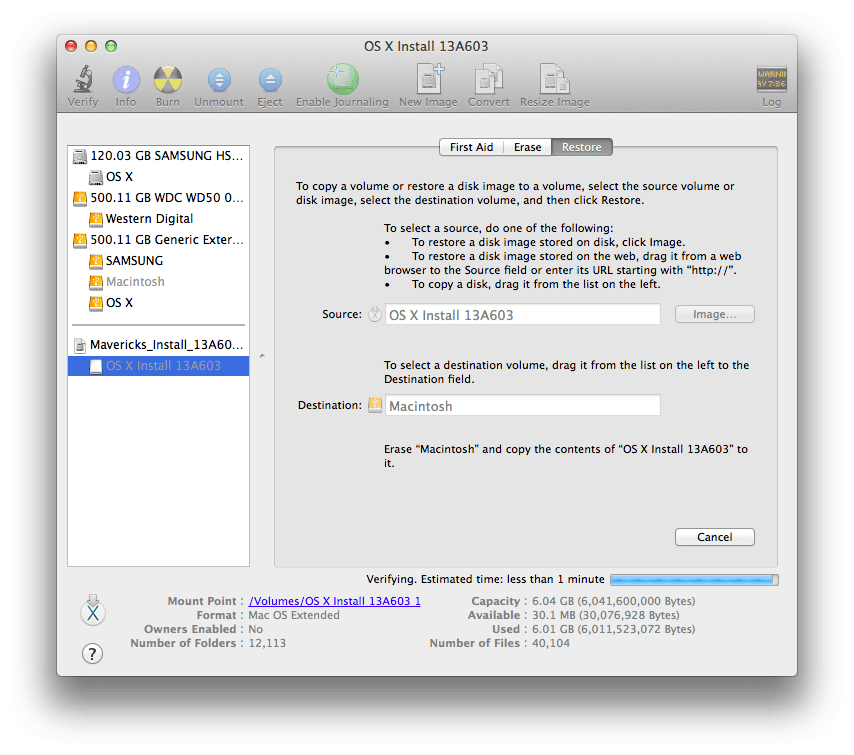

- DOWNLOAD OS X MAVERICKS INSTALL DISC MAC OS X
- DOWNLOAD OS X MAVERICKS INSTALL DISC DOWNLOAD
Navigate the file structure to System | Installation and delete the alias to the Packagesdirectory ( Figure J)
Once the files have finished copying over, the drive should mount automatically. The process may indicate in excess of one hour, but in my experience, the process takes significantly less time to complete ( Figure I). Upon verifying that the fields are correct, click the Restore button and select Erase from the application, if prompted to do so ( Figure H). For Destination, drag and drop the partition created on the USB drive onto the textbox ( Figure G) Drag the BaseSystem.dmg over to the Source text box. Go back to Disk Utility and click on the newly formatted USB Drive in the menu, then click on the Restore tab. dmg file and locate the hidden BaseSystem.dmg ( Figure F) Navigate the file structure Contents | Shared Support and double-click the InstallESD.dmg file mount OS X Install ESD on the desktop ( Figure E). Right-click the file and select Show Package Contents ( Figure D) DOWNLOAD OS X MAVERICKS INSTALL DISC MAC OS X
Upon completion of the USB formatting, locate Install Mac OS X Mavericks.app(downloaded in step #1 to the Applications folder, by default). Hit return, and again you will need to kill the Finder so that it can relaunch for changes to take effect: Remember the slight difference in OS X Mavericks has to do with capitalization:ĭefaults write AppleShowAllFiles FALSE As you can see, everything is the same except that TRUE has been switched to “FALSE”:ĭefaults write AppleShowAllFiles FALSE To hide files that are intended to be hidden again, thus going back to the default Mac settings of keeping them invisible, you can just type the following defaults command. Reverse to Default & Make Files Hidden Again Thankfully it’s just as easy to switch back. With all the files visible a Finder window can look much busier than you may be accustomed to, and it’s not always desired to leave on constantly. This setting stays in place until it has been reversed or disabled, which would cause all files to become hidden again just as the default. “Hidden” files are now visible in Finder windows, but they will display as a dimmed version of their respective file icons, being slightly transparent. This is done by ‘killing’ the Finder process, which is also done through the command line with the following string:Īgain, hit Enter/Return, and you’ll discover the Finder quits and relaunches itself very quickly with the changes in effect. Hit Return, nothing happens yet because you must relaunch the Finder for the changes to take effect. 
The first command activates the ability to see the hidden files:įor OS X Mavericks 10.9 there is a very slight difference in casing:ĭefaults write AppleShowAllFiles TRUEįor Mac OS X 10.8 Mountain Lion, 10.7 Lion, 10.6 Snow Leopard the setting remains the following:ĭefaults write AppleShowAllFiles TRUE Launch the Terminal (found in /Applications/Utilities) and enter these commands exactly as shown. defaults write AppleShowAllFiles TRUE \killall Finder \say Files Revealed Show Hidden Files on your MacThis changes the default setting of Mac OS X so that Finder always shows all files.Launch the Terminal.app by selecting it from the /Applications | Utilities folder and execute the following command ( Figure C)*:.
 Click on the Options button, select the radio button for GUID Partition Table, and click OK ( Figure B). Select Mac OS Extended (Journaled) for the format-type from the drop-down menu ( Figure A). Click the drop-down menu, selecting 1 partition. Click on the USB drive from the left-hand menu and select the Partition tab. Insert the USB drive into the Mac and launch Disk Utility.
Click on the Options button, select the radio button for GUID Partition Table, and click OK ( Figure B). Select Mac OS Extended (Journaled) for the format-type from the drop-down menu ( Figure A). Click the drop-down menu, selecting 1 partition. Click on the USB drive from the left-hand menu and select the Partition tab. Insert the USB drive into the Mac and launch Disk Utility. DOWNLOAD OS X MAVERICKS INSTALL DISC DOWNLOAD
Using a Mac with at least OS X 10.6.8 installed, access the Mac App Store and download the Mavericks (10.9) app installer.User Account with Administrative privileges.
 Apple computer with Mac App Store (OS X 10.6.8+). Install OS X Mavericks.app (installer downloaded from Mac App Store). Creating a USB Installer for Apple OS X 10.9īefore proceeding, you’ll need the following items to complete the process: However, the focus of this article is the change in the process for creating a working, bootable USB drive. The latest iteration of OS X, version 10.9 (aka Mavericks), marks not only 200+ changes in the OS, but also does away with the fabled “big cat” naming scheme. In April, I wrote an article on TechRepublic about how to create a bootable USB to install OS X.
Apple computer with Mac App Store (OS X 10.6.8+). Install OS X Mavericks.app (installer downloaded from Mac App Store). Creating a USB Installer for Apple OS X 10.9īefore proceeding, you’ll need the following items to complete the process: However, the focus of this article is the change in the process for creating a working, bootable USB drive. The latest iteration of OS X, version 10.9 (aka Mavericks), marks not only 200+ changes in the OS, but also does away with the fabled “big cat” naming scheme. In April, I wrote an article on TechRepublic about how to create a bootable USB to install OS X.








 0 kommentar(er)
0 kommentar(er)
